Behaviour of Steel-Concrete-Steel Sandwich Beams with Novel Enhanced C-Channels
Abstract
1. Introduction
2. Experimental Study
2.1. Materials
2.1.1. Concrete
2.1.2. FESEM and EDS Analysis of LWC
2.2. Steel
Test Specimen
2.3. Test Setup and Testing Procedure
2.4. Analysis of SCS Sandwich Beams Damage
Load—Deflection History
3. Theoretical Analysis
3.1. Flexural Behaviour
3.2. Shear Behavior
3.3. Combination of Bending Moment and Shear Force Resistance
3.4. Ductility and Energy Dissipation
3.5. Stiffness Degradation
4. Discussion
5. Conclusions
- In SCS sandwich beams with self-tapping screw connectors, the top and bottom steel plates are prevented from separating during tensile loads by self-tapping screw connectors. Self-tapping screw connection sandwich beams with SCS experienced three different types of failure. The lower steel plate failed due to bending, bending shear, and failure.
- Composite beams with enhanced C-channel shear connectors were tested. According to the test results, the EC shear connector can increase the vertical shear strength of the beam as well as the interfacial bonding of the steel faceplate and the inner core. However, the load-deflection and post-yield deflection of the SCSB-WL-150 were higher than the other SCS beams. That was due to the spacing of the shear connectors, which was more sufficient to carry the ultimate loads from the SCS beam.
- In addition, lightweight concrete (LWC)-filled sandwich composite beams were tested. The beam test was utilised to examine the ductility of various cold-form steel section patterns and ECs shear connector spacings. According to the test results, the sandwich beam with ECs shear connectors (SCSB-WL-150) has less ductility than SCSB-WL-100. The reason was that the ductility behavior was more due to the ECs shear connectors, which were closely fixed using a self-tapping screw connection. Compared to the beams un-lipped section, the ductility behavior of the lipped segment was enhanced. The energy dissipation of the SCS sandwich beam (SCSB-WL-150) was more than the other.
- The stiffness of SLCSB was not significantly affected by the spacing of the ECs. Although the local buckling of compression faceplates was caused by the increasing EC spacing, it did not affect the SLCSB-ECs overall bending strength because of the increased spacing from 100 to 150 mm.
- As beam strength and shear connector spacing increased, the load-deformation behavior of SCS-ECs beam specimens of WL150 improved drastically. The load and the deformation capacity of SCS beam specimens were enhanced by around 2–2.5 times compared to the other beam specimens. According to the test results, SLCSB-WL150 could successfully increase the beam specimen flexure and shear capability.
- The main focus of the proposed study was that the application of lightweight concrete in SCS beam specimens increased the beam’s shear capacity and load-carrying ability. The test results indicate that the SLCSB-WL150 beam has improved structural performance and increased flexural strength.
Author Contributions
Funding
Data Availability Statement
Conflicts of Interest
References
- Sohel, K.M.A.; Liew, J.R.; Yan, J.B.; Zhang, M.H.; Chia, K.S. Behavior of steel–Concrete–steel sandwich structures with lightweight cement composite and novel shear connectors. Compos. Struct. 2012, 74, 3500–3509. [Google Scholar] [CrossRef]
- Oduyemi, T.O.S.; Wright, H.D. An experimental investigation into the behaviour of double skin sandwich beams. J. Constr. Steel Res. 1989, 14, 197–220. [Google Scholar] [CrossRef]
- Liew, J.Y.R.; Sohel, K.M.A. Lightweight steel–concrete–steel sandwich system with J-hook connectors. Eng. Struct. 2009, 31, 1166–1178. [Google Scholar] [CrossRef]
- Liew, J.Y.R.; Sohel, K.M.A.; Koh, C.G. Impact tests on steel–concrete–steel sandwich beams with lightweight concrete core. Eng. Struct. 2009, 31, 2045–2059. [Google Scholar] [CrossRef]
- Varma, A.H.; Zhang, K.; Chi, H.; Booth, P.; Baker, T. In-Plane Shear Behavior of SC Composite Walls: Theory vs. Experiment. In Proceedings of the Transactions, SMiRT 21, New Delhi, India, 6–11 November 2011. Div-VI: Paper ID# 764. [Google Scholar]
- Mizuno, J.; Koshika, N.; Sawamoto, Y.; Niwa, N.; Yamashita, T.; Suzuki, A. Investigation on Impact Resistance of Steel Plate Reinforced Concrete Barriers Against Aircraft Impact. Part 1: Test Program and Results. In Proceedings of the 18th International Conference on Structural Mechanics in Reactor Technology (SMiRT 18), Beijing, China, 7–12 August 2005. SMiRT18-J05. [Google Scholar]
- Marshall, P.W.; Palmer, A.C.; Wang, T.Y.; Thein, M.K.W. Bond Enhancement for Sandwich Shell Ice Wall. In Proceedings of the International Conference and Exhibition on Performance of Ships and Structures in Ice, Anchorage, AK, USA, 20–23 September 2010. Paper No. 172. [Google Scholar]
- Remennikov, A.; Gan, E.C.J.; Ngo, T.; Netherton, M.D. The development and ballistic performance of protective steel-concrete composite barriers against hypervelocity impacts by explosively formed projectiles. Compos. Struct. 2019, 207, 625–644. [Google Scholar] [CrossRef]
- Roberts, T.M.; Edwards, D.N.; Narayanan, R. Testing and analysis of steel-concrete-steel sandwich beams. J. Constr. Steel Res. 1996, 38, 257–279. [Google Scholar] [CrossRef]
- Yan, J.B.; Liew, J.Y.R.; Zhang, M.H.; Sohel, K.M.A. Experimental and analytical study on ultimate strength behavior of steel-concrete-steel sandwich composite beam structures. Mater. Struct. 2015, 48, 1523–1544. [Google Scholar] [CrossRef]
- Yan, C.; Wang, Y.; Zhai, X. Low velocity impact performance of curved steel-concrete- steel sandwich shells with bolt connectors. Thin-Walled Struct. 2020, 150, 106672. [Google Scholar] [CrossRef]
- Xie, M.; Foundoukos, N.; Chapman, J.C. Static tests on steel-concrete-steel sandwich beams. J. Constr. Steel Res. 2007, 63, 735–750. [Google Scholar] [CrossRef]
- Leekitwattana, M.; Boyd, S.W.; Shenoi, R.A. Evaluation of the transverse shear stiffness of a steel bi-directional corrugated-strip-core sandwich beam. J. Constr. Steel Res. 2011, 67, 248–254. [Google Scholar] [CrossRef]
- Leng, Y.B.; Song, X.B.; Chu, M.; Ge, H.H. Experimental study and theoretical analysis of resistance of steel-concrete-steel sandwich beams. J. Struct. Eng. 2015, 141, 1–11. [Google Scholar] [CrossRef]
- Yan, J.B.; Guan, H.; Wang, T. Steel-UHPC-steel sandwich composite beams with novel enhanced C-channel connectors: Tests and analysis. J. Constr. Steel Res. 2020, 170, 106077. [Google Scholar] [CrossRef]
- Yan, J.B.; Guan, H.N.; Wang, T. Finite element analysis for flexural behaviours of SCS sandwich beams with novel enhanced C-channel connectors. J. Build. Eng. 2020, 31, 101439. [Google Scholar] [CrossRef]
- Yan, J.B.; Wang, Z.; Wang, T. Shear and tensile behaviors of headed stud connectors in double skin composite shear wall. Steel Compos. Struct. 2018, 26, 759–769. [Google Scholar]
- Malek, N.; Machida, A.; Mutsuyoshi, H.; Makabe, T. Steel–Concrete sandwich members without shear reinforcement. Trans. Jpn. Concr. Inst. 1993, 15, 1279–1284. [Google Scholar]
- Yousefi, M.; Ghalehnovi, M. Push-out test on the one end welded corrugated-strip connectors in steel-concrete-steel sandwich structure. Steel Compos. Struct. 2017, 24, 23–35. [Google Scholar] [CrossRef]
- Yousefi, M.; Ghalehnovi, M. Finite element model for interlayer behavior of double skin steel-concrete-steel sandwich structure with corrugated-strip shear connectors. Steel Compos. Struct. 2018, 27, 123–133. [Google Scholar]
- Yan, J.B.; Liew, J.Y.R.; Qian, X.; Wang, J.Y. Ultimate strength behavior of curved steel-concrete-steel sandwich composite beams. J. Constr. Steel Res. 2015, 115, 316–328. [Google Scholar] [CrossRef]
- Yan, C.; Wang, Y.; Zhai, X.; Meng, L.; Zhou, H. Experimental study on curved steelconcrete-steel sandwich shells under concentrated load by a hemi-spherical head. Thin-Walled Struct. 2019, 137, 117–128. [Google Scholar] [CrossRef]
- Yan, C.; Wang, Y.; Zhai, X.; Meng, L. Strength assessment of curved steel-concretesteel sandwich shells with bolt connectors under concentrated load. Eng. Struct. 2020, 212, 110465. [Google Scholar] [CrossRef]
- Sjaarda, M.; West, J.S.; Scott, W. Performance of embedded bolt shear connectors. Struct. Eng. Int. 2020, 30, 421–429. [Google Scholar] [CrossRef]
- Pavlović, M.; Marković, Z.; Veljković, M.; Buđevac, D. Bolted shear connectors vs. headed studsbehaviour in push-out tests. J. Constr. Steel Res. 2013, 88, 134–149. [Google Scholar] [CrossRef]
- Lin, Y.; Yan, J.; Wang, Z.; Fan, F.; Yang, Y.; Yu, Z. Failure mechanism and failure patterns of SCS composite beams with steel-fiber-reinforced UHPC. Eng. Struct. 2020, 211, 110471. [Google Scholar] [CrossRef]
- Lin, Y.; Yan, J.; Cao, Z.; Zeng, X.; Fan, F.; Zou, C. Ultimate strength behaviour of SUHPC-S and SCS sandwich beams under shear loads. J. Constr. Steel Res. 2018, 149, 195–206. [Google Scholar] [CrossRef]
- Yan, J.B.; Hu, H.; Wang, T. Flexural behaviours of steel-UHPC-steel sandwich beams with J-hook connectors. J. Constr. Steel Res. 2020, 169, 106014. [Google Scholar] [CrossRef]
- Remennikov, A.M.; Kong, S.Y.; Uy, B. The response of axially restrained noncomposite steel-concrete-steel sandwich panels due to large impact loading. Eng. Struct. 2013, 49, 806–818. [Google Scholar] [CrossRef]
- Wang, Y.; Liew, J.Y.R.; Lee, S.C. Experimental and numerical studies of noncomposite steel-concrete-steel sandwich panels under impulsive loading. Mater. Des. 2015, 81, 104–112. [Google Scholar] [CrossRef]
- Wang, Y.; Liew, J.Y.R.; Lee, S.C. Theoretical models for axially restrained steelconcrete- steel sandwich panels under blast loading. Int. J. Impact Eng. 2015, 76, 221–231. [Google Scholar] [CrossRef]
- Guo, Q.; Zhao, W. Displacement response analysis of SC composite panels subjected to impact loadings. Int. J. Impact Eng. 2019, 131, 272–281. [Google Scholar] [CrossRef]
- Yan, J.B.; JYR, L.; Zhang, M.H.; Wang, J.Y. Ultimate strength behaviour of steel-concretesteel sandwich composite structures, part 1: Experimental and analytical study. Steel Compos. Struct. 2014, 17, 907–927. [Google Scholar] [CrossRef]
- Wang, A.J.; Chung, K.F. Advanced finite element modelling of perforated composite beams with flexible shear connectors. Eng. Struct. 2008, 30, 2724–2738. [Google Scholar] [CrossRef]
- Yan, J.B.; JYR, L.; Zhang, M.H. Ultimate strength behaviour of steel-concrete-steel sandwich composite structures, part 2: Finite element analysis. Steel Compos. Struct. 2015, 18, 1001–1021. [Google Scholar] [CrossRef]
- Yan, J.B. Finite element analysis on finite element analysis on ultimate strength behaviourof steel-concrete-steel sandwich composite beam structures. Mater. Struct. 2015, 48, 1645–1667. [Google Scholar] [CrossRef]
- Wang, Y.; Sah, T.P.; Lu, J.; Zhai, X. Behaviour of steel-concrete-steel sandwich beams with bold connectors under off-center impact load. J. Constr. Steel Res. 2021, 186, 106889. [Google Scholar] [CrossRef]
- Lee, J.; Kim, S.-M.; Park, H.-S.; Woo, B.-H. Optimum design of cold-formed steel channel beams using micro Genetic Algorithm. Eng. Struct. 2005, 27, 17–24. [Google Scholar] [CrossRef]
- Lim, J.B.P.; Nethercot, D.A. Ultimate strength of bolted moment-connections between cold-formed steel members. Thin-Walled Struct. 2003, 41, 1019–1039. [Google Scholar] [CrossRef]
- Khatibi, S.H.; Arab, H.G.; Miri, M. The behavior of steel-concrete-steel sandwich composite beams with box-profile shear connectors: Experimental and numerical. Structures 2023, 54, 644–656. [Google Scholar] [CrossRef]
- Liu, X.; Tang, L.; Jing, Y.; Xiang, J.; Tian, X.; Liu, W.; Huang, Y.; Zhang, G.; Zhao, W.; Yang, G. Behaviour of continuous steel–concrete composite beams strengthened with CFRP sheets at hogging-moment region. Compos. Struct. 2022, 291, 115695. [Google Scholar] [CrossRef]
- Su, C.; Wang, X.; Ding, L.; Wu, Z. Seismic degradation behavior of steel-FRP composite bar reinforced concrete beams in marine environment based on experimental and numerical investigation. Compos. Struct. 2023, 313, 116949. [Google Scholar] [CrossRef]
- Shakarami, M.; Zeynalian, M.; Ataei, A. Numerical study of the behavior of friction-grip bolted shear connectors in composite beams with cold-formed steel sections. Thin-Walled Struct. 2023, 184, 110539. [Google Scholar] [CrossRef]
- Dar, M.A.; Subramanain, N.; Ghowsi, A.F.; Anbarasu, M.; Hajirasouliha, I.; Haris, S.; Dar, A.R. Intermittently stiffened cold-formed steel GFRP composite lightweight built-up beams: Experimental investigation and performance assessment. Thin-Walled Struct. 2023, 185, 110630. [Google Scholar] [CrossRef]
- Ungureanu, V.; Both, I.; Burca, M.; Radu, B.; Neagu, C.; Dubina, D. Experimental and numerical investigations on built-up cold-formed steel beams using resistance spot welding. Thin-Walled Struct. 2021, 161, 107456. [Google Scholar] [CrossRef]
- Xiong, G.; Li, W.; Wang, X.; Liu, J.; Bai, Y.; Chen, Y.F. Flexural behavior of prefabricated high-strength steel-concrete composite beams with steel block connectors. J. Constr. Steel Res. 2022, 197, 107507. [Google Scholar] [CrossRef]
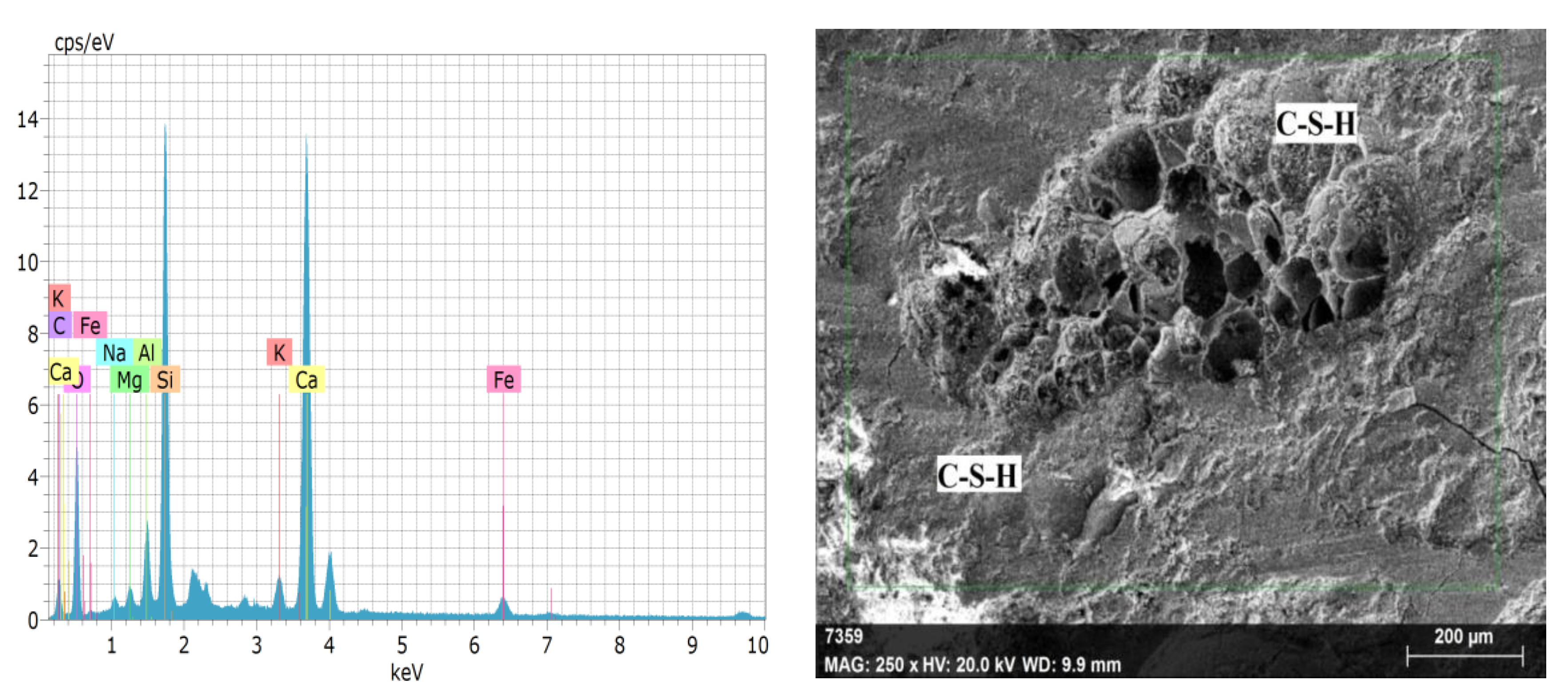

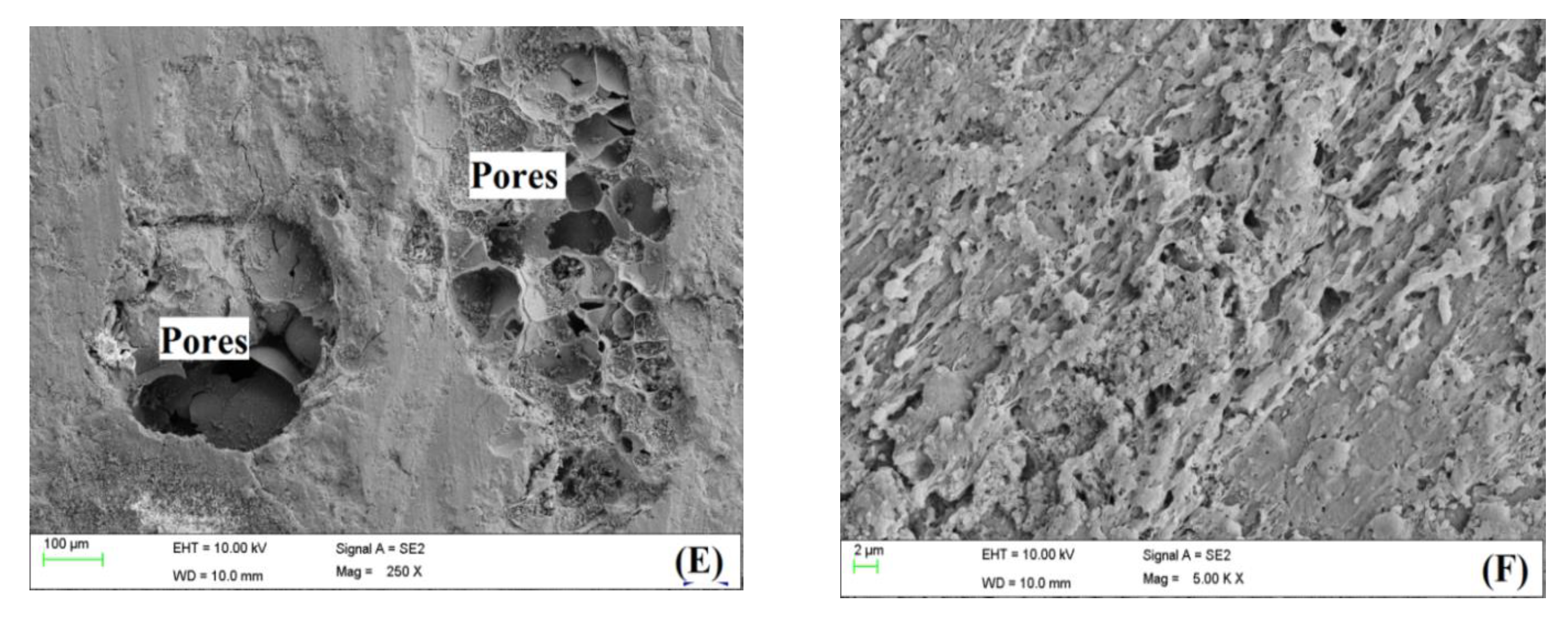
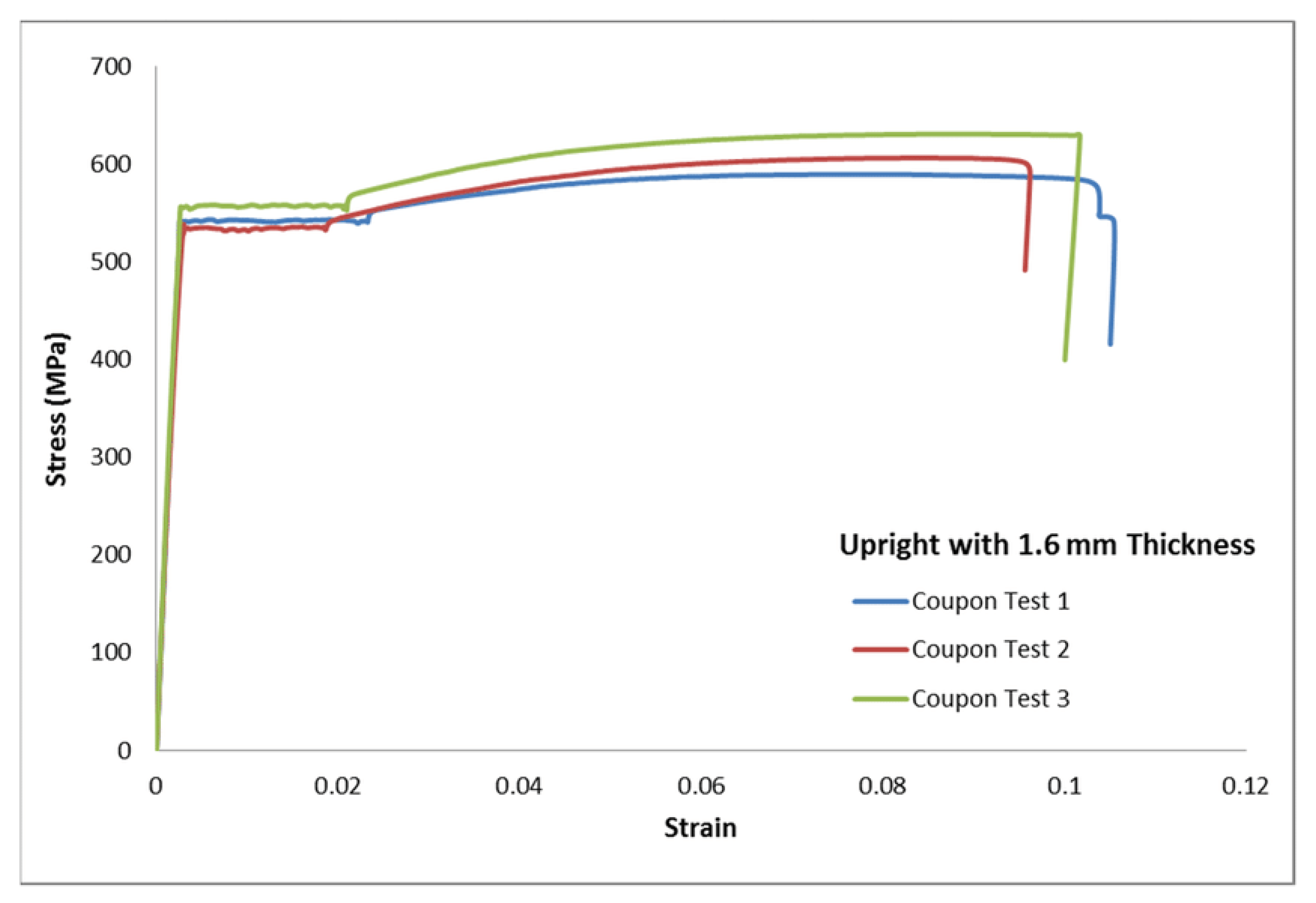

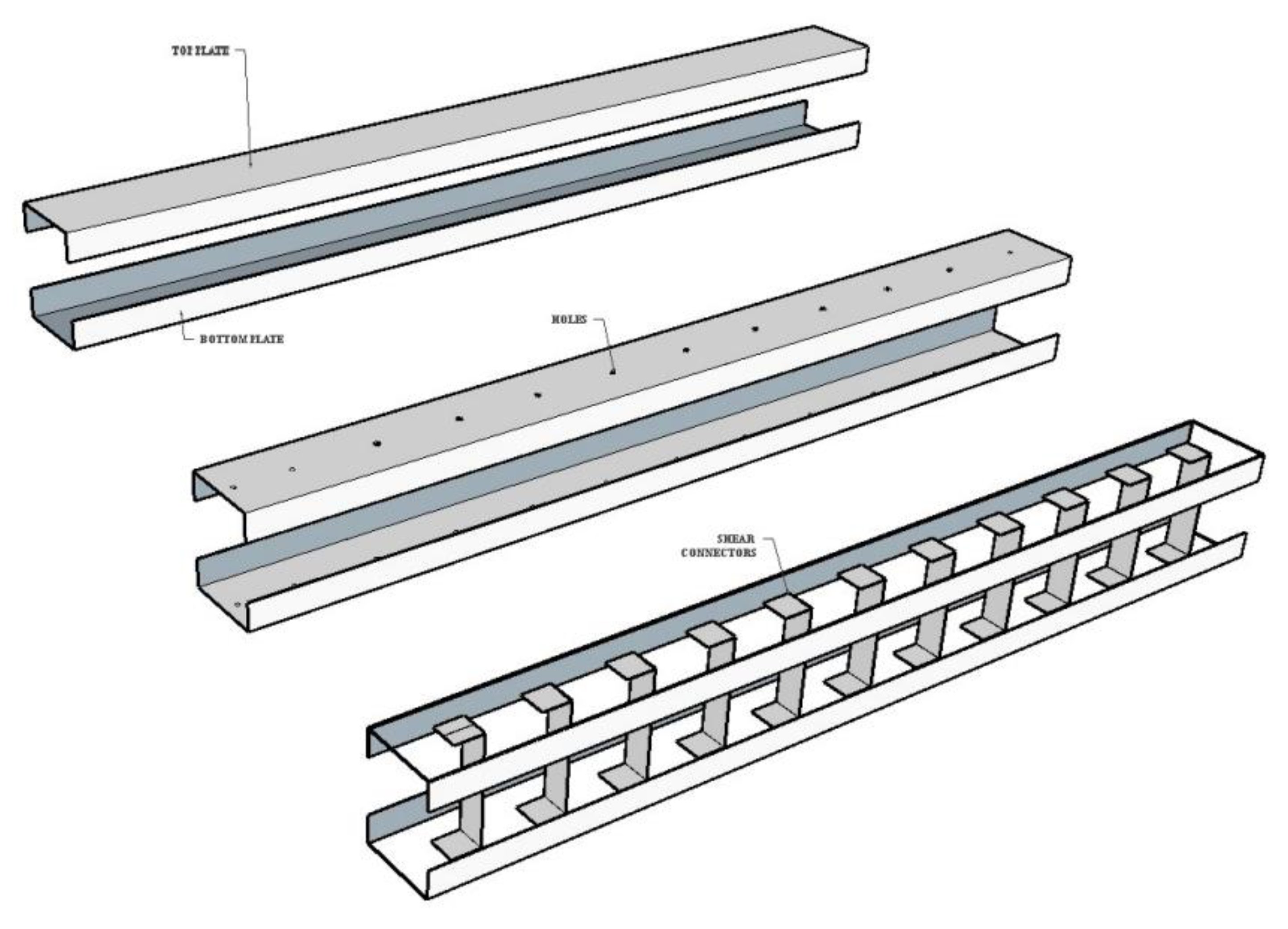
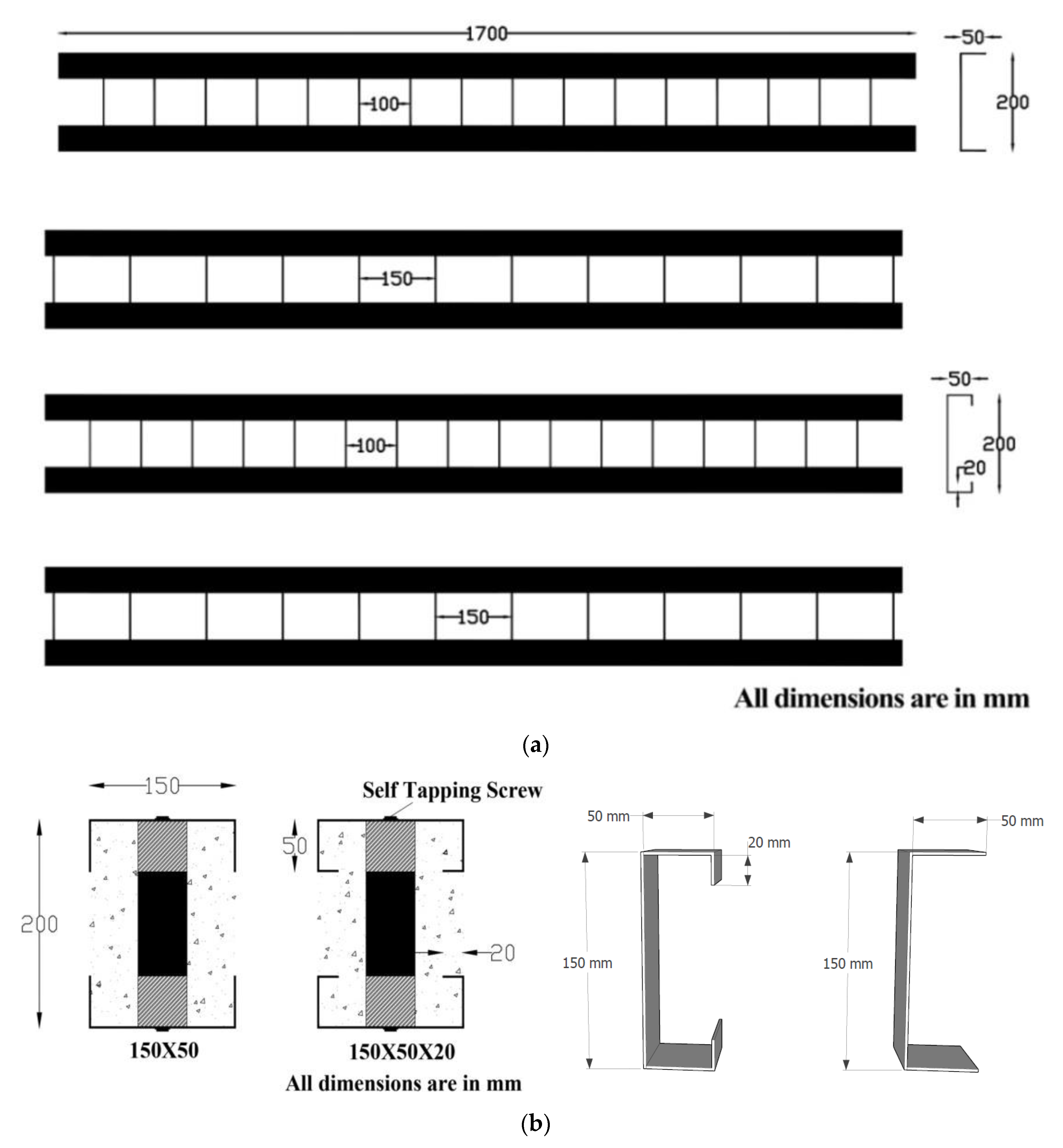
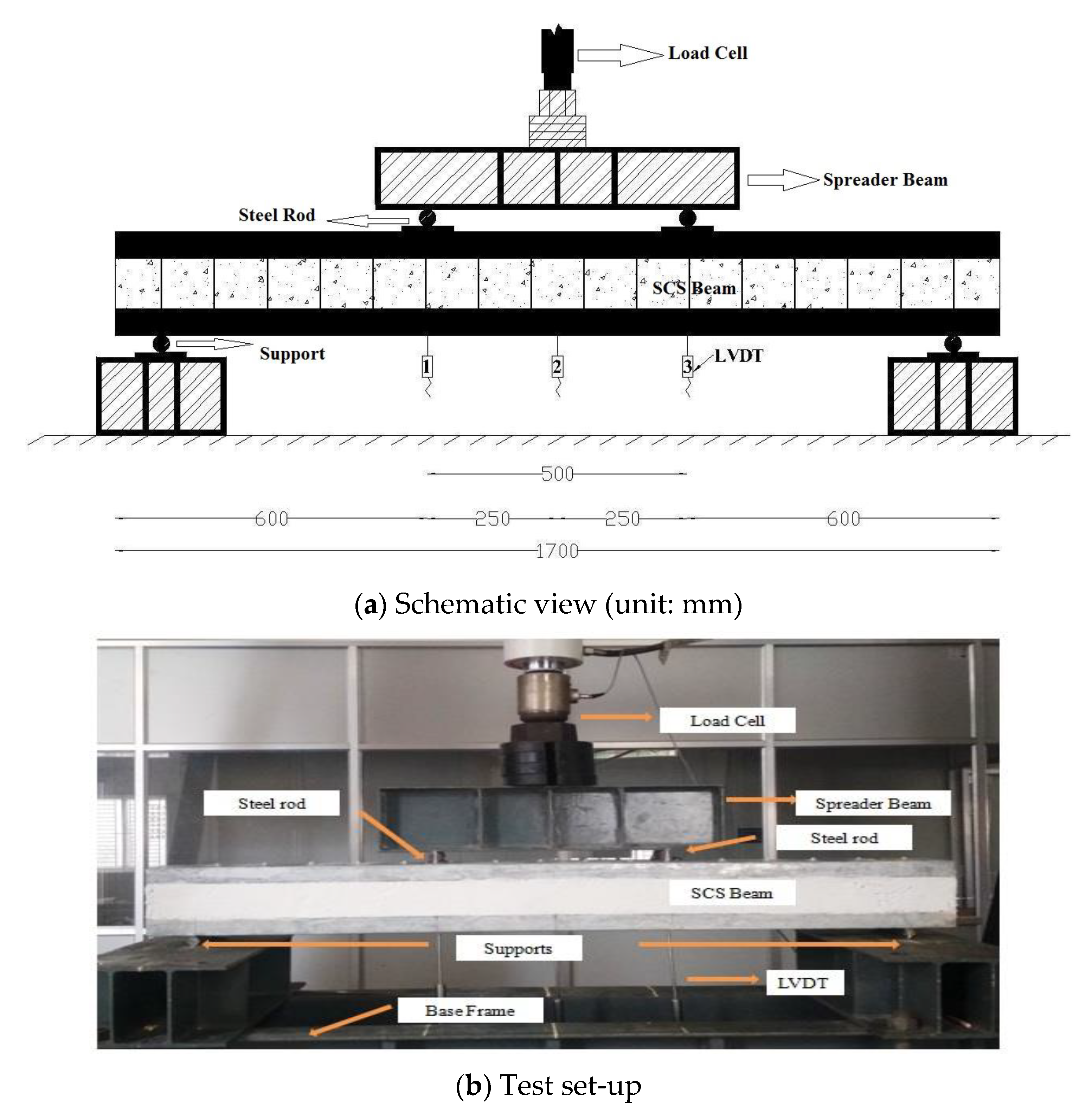
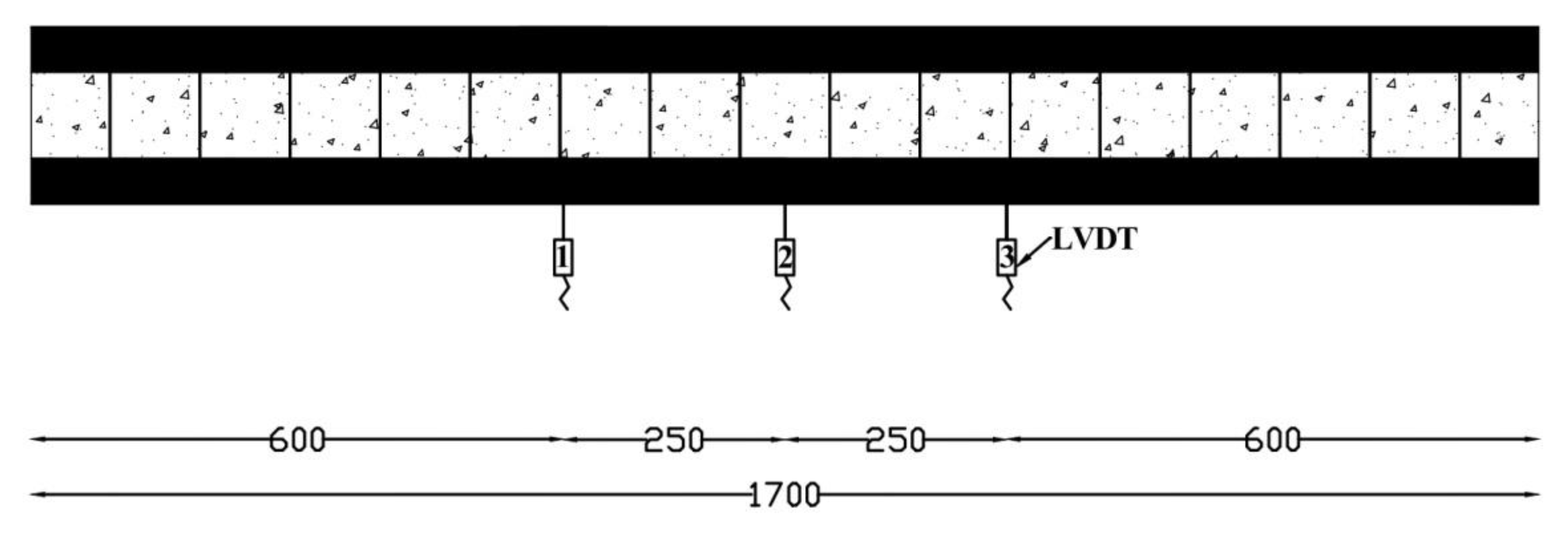


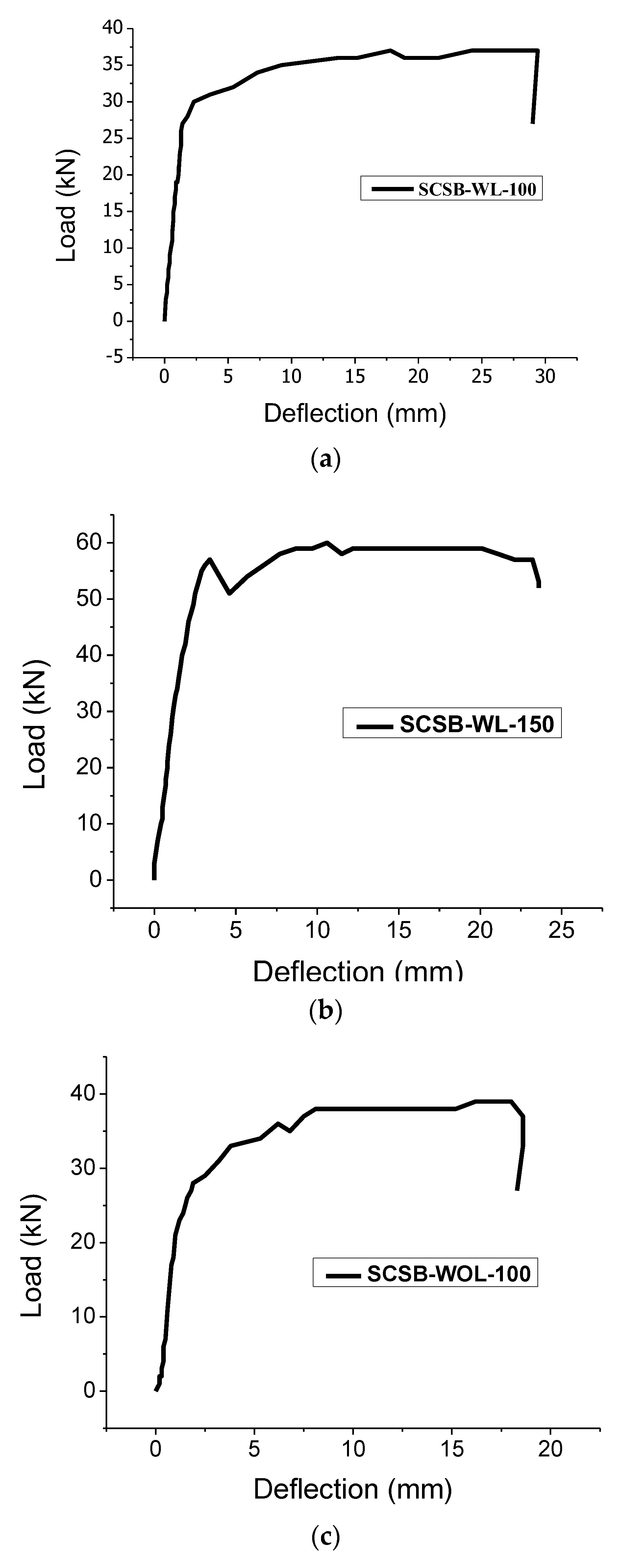

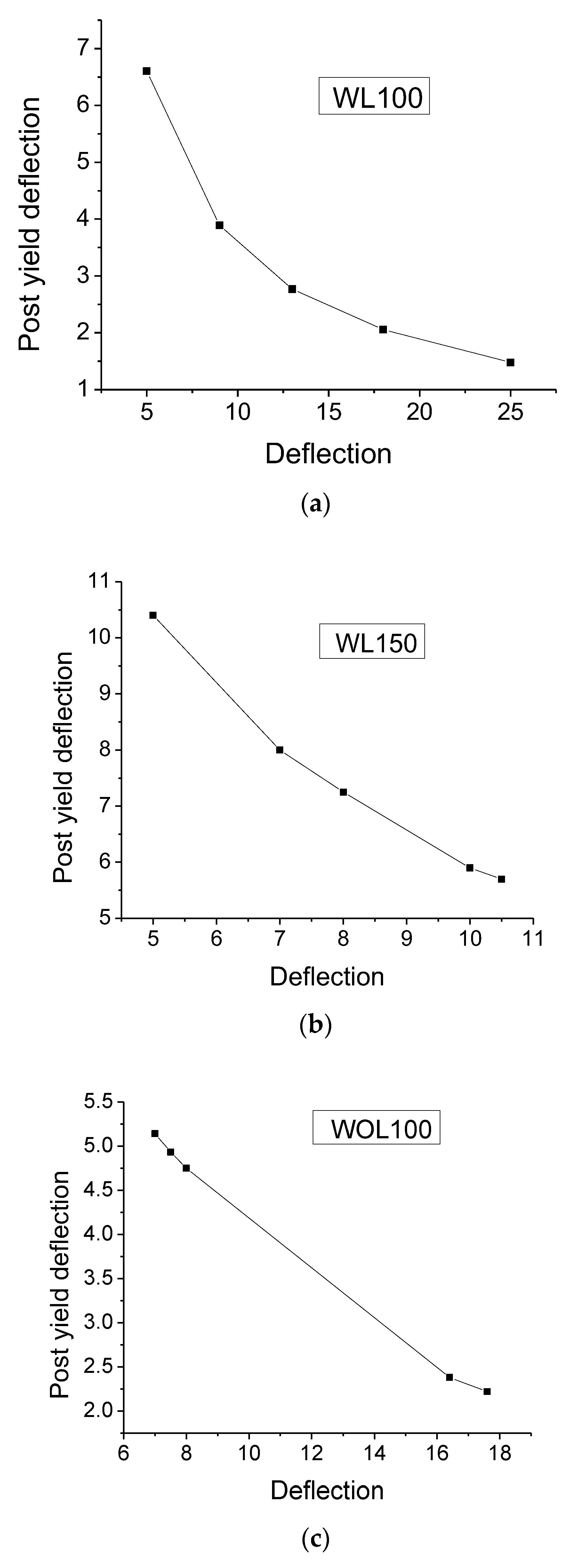




| Lightweight Concrete | CompressiveStrength of Concrete (MPa) | Young’s Modulus for Concrete (GPa) | Density of Concrete (kg/m3) |
|---|---|---|---|
| 17.65 | 36.74 | 1438.48 | |
| CFS plate | ts (mm) | Yield strength of steel (MPa) | Young’s modulus for steel (GPa) |
| 1.6 | 310.92 | 186.65 | |
| Self Tapping Screw (STS) | Diameter (mm) | yield strength of steel (MPa) | Young’s modulus for steel (GPa) |
| 6.25 | 640 | 210.00 |
| Beam ID | Type | Thickness of Steel Plate (mm) | Width of Beam (mm) | Diameter of Bolt (mm) | Depth of Concrete Core (mm) | Spacing of Connectors (mm) |
|---|---|---|---|---|---|---|
| SLCSB1 | WL | 1.6 | 150 | 6.25 | 196.8 | 100 |
| SLCSB2 | WL | 1.6 | 150 | 6.25 | 196.8 | 150 |
| SLCSB3 | WOL | 1.6 | 150 | 6.25 | 196.8 | 100 |
| SLCSB4 | WOL | 1.6 | 150 | 6.25 | 196.8 | 150 |
| Beam ID | Type | SC (mm) | Fmax (kN) | D0 (mm) | Dmax (mm) | Dp (mm) |
|---|---|---|---|---|---|---|
| SLCSB1 | WL | 100 | 37 | 0.10 | 29.4 | 9.2 |
| SLCSB2 | WL | 150 | 60 | 0.20 | 23.6 | 18 |
| SLCSB3 | WOL | 100 | 39 | 0.20 | 18.6 | 12.3 |
| SLCSB4 | WOL | 150 | 44 | 0.10 | 24.1 | 18.9 |
| Beam ID | Yield Stage | Ductility (µ) | Energy Dissipation (kN-mm) | Initial Stiffness (Ki) | Yield Stiffness (Ky) | |
|---|---|---|---|---|---|---|
| Py (kN) | Δy (mm) | |||||
| WL100 | 37 | 25 | 14.35 | 790.32 | 0.77 | 1.02 |
| WOL100 | 39 | 17.6 | 5.63 | 474.24 | 1.44 | 1.93 |
| WL150 | 60 | 10.5 | 11.3 | 1008 | 3.4 | 4.53 |
| WOL150 | 41.5 | 23.5 | 2.87 | 528 | 1.82 | 2.43 |
Disclaimer/Publisher’s Note: The statements, opinions and data contained in all publications are solely those of the individual author(s) and contributor(s) and not of MDPI and/or the editor(s). MDPI and/or the editor(s) disclaim responsibility for any injury to people or property resulting from any ideas, methods, instructions or products referred to in the content. |
© 2023 by the authors. Licensee MDPI, Basel, Switzerland. This article is an open access article distributed under the terms and conditions of the Creative Commons Attribution (CC BY) license (https://creativecommons.org/licenses/by/4.0/).
Share and Cite
Ayyadurai, A.; Shanmugam, B.; Ravindran, G. Behaviour of Steel-Concrete-Steel Sandwich Beams with Novel Enhanced C-Channels. Buildings 2023, 13, 1956. https://doi.org/10.3390/buildings13081956
Ayyadurai A, Shanmugam B, Ravindran G. Behaviour of Steel-Concrete-Steel Sandwich Beams with Novel Enhanced C-Channels. Buildings. 2023; 13(8):1956. https://doi.org/10.3390/buildings13081956
Chicago/Turabian StyleAyyadurai, Ananthakumar, Balaji Shanmugam, and Gobinath Ravindran. 2023. "Behaviour of Steel-Concrete-Steel Sandwich Beams with Novel Enhanced C-Channels" Buildings 13, no. 8: 1956. https://doi.org/10.3390/buildings13081956
APA StyleAyyadurai, A., Shanmugam, B., & Ravindran, G. (2023). Behaviour of Steel-Concrete-Steel Sandwich Beams with Novel Enhanced C-Channels. Buildings, 13(8), 1956. https://doi.org/10.3390/buildings13081956







